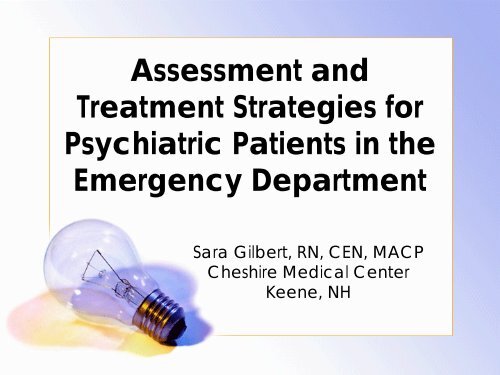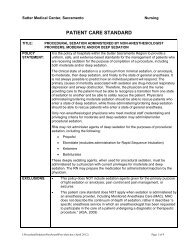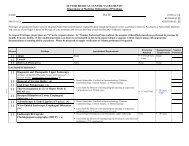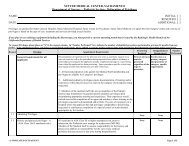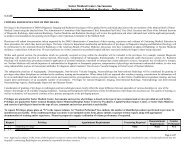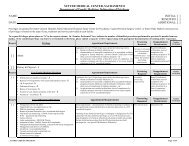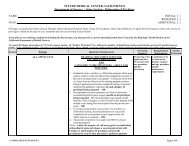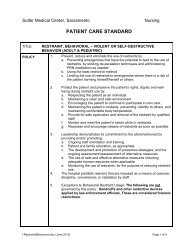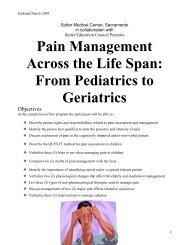Psychiatric Crash Cart Presentation - Sutter Medical Center
Psychiatric Crash Cart Presentation - Sutter Medical Center
Psychiatric Crash Cart Presentation - Sutter Medical Center
You also want an ePaper? Increase the reach of your titles
YUMPU automatically turns print PDFs into web optimized ePapers that Google loves.
Objectives• Recognize the importance of symptom managementfor psychiatric patients• Gain understanding of psychiatric diagnoses andassociated symptoms• Identify patients at high risk for suicidality, self-harmand acting out behaviors• Learn specific strategies for dealing with a variety ofbehavioral issues• Identify characteristics of “special populations”• Gain insight regarding therapeutic rapport,nonjudgmental attitude and alliance
“I don’t have an attitude!”THE IMPORTANCE OF SYMPTOM MANAGEMENT• Anxiety drives many problematic behavioral symptoms• Anxiety Agitation Aggression• Symptom management reduces anxiety, acting out, need forrestraints and enhances cooperation of patient and family• Avoid the attitudes and behaviors that increase patientanxiety and frustration …don’t REACT:R: restrictE: escalateA: avoidC: coerceT: threaten
“What’s YOUR problem?”Common <strong>Psychiatric</strong> Disorders• Borderline Personality Disorder• Bipolar Disorder (Manic Depression)• Psychosis/Schizophrenia• Depression (Major Depressive Disorder)• Anxiety Disorders**Symptoms can range from mild to severe.
Borderline Personality DisorderBehaviors/Thinking• Manipulation, power struggles, passive-aggressivecommunication• Tend to want you to know what they want, withouttelling you directly• Unpredictable, “gamey” around safety issues,attention-seeking, dramatic, provocative• Can be argumentative; have difficulty takingresponsibility for behaviors e.g. may blame dissociationor “voices”• High risk for self-harming behaviors• Can be chronically suicidal with many “attempts”• Black and white thinking
Borderline Personality DisorderEmotions:• Angry, labile, depressed, overwhelmed, needy• Hypersensitive to “rejection,” criticism, negativeattitude• Easily frustrated, agitated• Anxiety around being poorly treated, ignored, etc iscommon trigger for acting out
Borderline Personality DisorderSpecific Strategies:• AVOID POWER STRUGGLES!• Give choices as often as possible; clear, reasonable limits• Don’t react emotionally to behaviors, know your own“buttons”• No punitive treatments, threats, ultimatums or excessiverestrictions-they will give the patient a reason to escalate• Spend time (if you can) talking with the patient to find outwhat they need and want; try to accommodate them if youare able (explain why if you can’t)• Be aware of non-verbal communication• Explain the process involved, try to decrease anxiety asmuch as possible• Check back with the pt. often• Expedite process of evaluation
“Who needs sleep????”Bipolar Disorder• Also known as Manic-Depressive illness, characterized bycycles of extreme mood swings and behaviors• Involves disruption in normal brain chemistry, often with afamilial component• Not curable, can be managed• Young, undiagnosed Bipolar patients often “self-medicate”• Manic behaviors can result in loss of job, relationships, etc.which can increase instability• High risk for “accidentally” or intentionally killing self• May not be taking medications
Bipolar DisorderBehaviors/Thinking (manic phase):• Delusions of “grandiosity,” may feel invincible• Impulsiveness with little regard for personal safety orconsequences of actions; high risk behaviors• Racing thoughts, tangential thinking make it difficult tofollow directions or complete tasks e.g. giving UA• Grandiose, delusional, paranoid, may see some psychosis;perceive themselves as being superior• Poor boundaries, inappropriate language; loud, frequentchange of subjects, interrupting• Often have little intent to be disruptive or oppositional• Poor sleep, hygiene and nutrition in acute manic phase• Rapid, pressured speech
Emotions:Bipolar Disorder• Euphoric, energized, confident• Labile, anxious, paranoid, feeling “invincible” to harmand superior to others• Impatient, easily frustrated when process is slower thanthey think it should be• Confusion as to why others are concerned about them
Bipolar DisorderSpecific strategies:• Low stimulus, keep directions/statements short andsimple (may have to repeat them)• Don’t argue with the pt.; say “you’re right” as much aspossible in order to make it easier to set limits whennecessary• Medicate early for agitation, get a reliable sitter• New onset mania needs medical workup andprobably hospitalization• Assume pt. will be unpredictable and plan for it• Check medication levels
“I think that doctor is from the CIA!”Psychosis/Schizophrenia• Characterized by disorganization in thinking, delusions/hallucinations and some emotional “flatness”• Schizophrenia onset typically late adolescence, early20’s• Psychosis can be drug induced or related to otherdisorders such as Bipolar or depression• Typically don’t realize that their thinking is delusional orirrational ; may not understand what is happening tothem• New onset vs. established diagnosis?• New onset: families can often be in denial
Psychosis/SchizophreniaBehaviors/Thinking:• Paranoid, hyper-vigilant, responding to voices, religiousreferences, delusions• May extend their paranoia to include staff• May believe that that others are reading their thoughts,secretly plotting against them• Socially withdrawn, focused on delusions• Not typically violent/aggressive to others• Could be self-harming or suicidal, if having commandhallucinations• May be uncooperative with an aggressive approach
Psychosis/SchizophreniaEmotions:• Can be very frightened, anxious• Emotionally withdrawn, suspicious, paranoid• May not be willing to share what they are feeling;affect may be blunted
Psychosis/SchizophreniaSpecific Strategies:• Approach slowly, using non-threatening body language• Don’t feed into delusions, but don’t directly contradict themeither e.g. “That sounds very frightening.”• Ask about voices, what they are saying, how the patientfeels about them (some are “friendly voices”)• Assess cognitive functioning to determine level ofdisorganization• If the patient is there due to safety issues, ask what would behelpful to them to feel safe in the ER• Low stimulus, medicate for agitation, consider medicaletiology if new symptoms• New onset? Plan for hospitalization and family education
“I really think my kids would be better off without me….”Depression• Acute vs. chronic (Major Depressive Disorder,dysthymia)• MDD can be a progressive illness; if left untreated canlead to SI with “loss” of ability to perceive situations inrational, objective way• Multiple stressors, recent trauma (especially with PTSDissues), perceived loss of control, difficulty inrelationships, medical issues can be precipitants• Genetics, personality, environment can make a personmore susceptible• Physical symptoms e.g. fatigue, headaches, nausea
DepressionBehaviors/Thinking:• Usually cooperative in the ER, especially if no other psychissues involved (e.g. personality disorder, substance abuse)• Tend to not ask for what they need/want , believe they are aburden or that they can’t trust others to care for them• May or may not have intent to hurt self, may or may notwant hospitalization vs. being set up with services• Poor sleep/ hygiene, inability to function, impaired judgment,lack of motivation, difficulty making decisions• May be trying to please others vs. caring for themselves; maynot assert themselves around getting the care they need• Negative, unrealistic thinking
DepressionEmotions:• Affect can be flat, sad, tearful• Overwhelmed, anxious, scared, guilty, sad, insecure,hopeless• May be angry at someone, usually don’t take it out onus• Can easily shut down if they perceive negativity fromstaff
DepressionSpecific Strategies:• Ask what they need from ER visit, explain options e.g.connect with services• Assess extent of depression to avoid excessive restrictions• Be kind, explain what is happening; give reassurance thatyou want to help them• Offer food, warmth, comfort; may need to ask more thanonce• Ask about stressors, supports, therapists, allow family/friends ifpatient wants them• Ask about SI (vague thoughts vs. plan with intent, can helppinpoint how far the depression has progressed)
“I’m pretty sure I’m having a heart attack!”Anxiety/Anxiety Disorders• Anxiety sets off a cascade of physical, emotional and cognitivesymptoms that can overwhelm pt.• Anxiety is a more difficult emotion to handle than anger ordepression• Patients often self-medicate with drugs, etoh• Panic attacks, phobias, PTSD-related anxiety can quickly becomemedical problems if not managed• During panic attacks, patients are unable to process what is beingsaid to them• Anxiety is a strong component of many other disorders e.g.depression, schizophrenia• Physical symptoms can include nausea, chest tightness, dizziness,headache etc
Anxiety/Anxiety DisordersBehaviors/Thinking:• Repetitive, irrational thoughts; inability to controlanxious thoughts• Difficulty concentrating or making decisions• Can be difficult to redirect, restless, impatient• May escalate if physical symptoms are dismissed ornegated• Impulsive, poor judgment; avoidance as coping• May react out of proportion to staff’s interactions• Excessive worrying, may repeatedly ask the samequestions
Anxiety/Anxiety DisordersEmotions:• Feelings of dread, sense of impending doom• Irritable, edgy, preoccupied with physical symptoms• “Anxious about being anxious”• Overwhelmed, easily frustrated, feeling of powerlessness; lack oftrust in staff• Frightened, may feel like they are “losing control”• Can escalate to anger, which may be easier for them to tolerate
Anxiety/Anxiety DisordersSpecific Strategies:• Recognize, treat the physical symptoms as real• Assess the pt.’s understanding of what is happening• Offer reassurance e.g. “I know you are frightened but weare going to take care of you.”• Specifically ask what would be most helpful to them• Needle phobias, hyperventilation• Ask what has worked for them in the past when dealing withtheir anxiety• Family/friends involvement• Humor, distraction are helpful with mild-moderate anxiety
Assessing Suicidal RiskVariations in Suicidal Ideation:• Chronic vs. acute• Fleeting vs. vague vs. specific• No intent vs. passive intent vs. clear intent• Impulsive vs. planned• Self-harm vs. gesture vs. attempt
Assessing Suicidal RiskRED FLAGS:• Planned attempt, no regret• Did not tell anyone• Unhappy about being alive• No “future” plans• Very irrational thinking• Specific plan, with means• Lethality of attempt• Can not contract for safety
Assessing Suicidal RiskSpecific Strategies:• Assess level of SI• Do not minimize/dismiss lethality of attempt or patients’stressors, feelings• Do not attempt to “talk pt. out of it”• Avoid backing suicidal pt. “into a corner”• Listen in a nonjudgmental way, avoid offering “advice”• Check with pt. before allowing visitors, phone calls• ? Safety contract• Explain to pt. what the process involved in formalassessment
Special PopulationsGeriatric Patients:• Assess past history of mental health issues• Unlikely to develop personality disorders, bipolar disorder orschizophrenia past age 60• High risk for depression/suicide, esp. males, but depression is not anormal part of aging• Illness, losses, financial problems, caring for incapacitated spouse mayincrease risk of mental health issues (either exacerbation of chronic ornew onset)• May have difficulty identifying their own depression, or asking for help• Ask “What is most difficult for you right now?” to begin discussion• Evaluate support systems, access to services, changes in level offunctioning
Special PopulationsAdolescents:• Rapport with parent and patient is crucial to management; avoidauthoritarian approaches• Assess safety, ability to cooperate with and understand process,relationship with parents• Common stressors for teens that lead to SI include parentaldivorce/conflict, relationship breakups, bullying, school problems• Speak to adolescent first; avoid asking about what you already know• Separate parents from kids when appropriate; do not “take sides”with parent or adolescent• Ask about self-harming , SI without parent present• Allow adolescent to “save face,” have some control, modesty• Avoid taking behaviors personally• Remember, bribery (aka “negotiation”) is underrated
Special Populations<strong>Medical</strong>-Psych• Both medical and psych illnesses can exacerbate each other;important to maintain awareness• Assess psych illness with pt.’s cooperation, e.g. ask abouteffectiveness of medications, sleep, stress level, supports;“Please let us know if anything changes”• Medications/NPO status• Educate patients about mental health issues that may resultfrom medical illnesses• Avoid dismissing physical symptoms as part of psych illness,without appropriate assessment• Consistency among shifts with difficult pts. (?need for careplan)
Special PopulationsSubstance Abusers:• Can be high risk for self-harming, suicidal behaviors• May have co-morbid psych illnesses, which will complicate treatment(e.g. bipolar disorder, borderline personality)• Self-medication for anxiety, depression, anger issues• Assess “how far” pt. is into addictive process; ask about effects onsupports, functioning, finances• Avoid judgmental attitudes and behaviors• Avoid “direct” suggestions e.g. AA• Explain sequence of “tolerance, dependence, addiction”• Limit education to “most important thing”• Educate family about caring for themselves, when necessary (e.g.Alanon, CODA, Alateen)
The Therapeutic RelationshipMain components:• Therapeutic Rapport: consistency, reliability,confidentiality, safety, trust, respect• Nonjudgmental attitude: acceptance, validation,compassion, empathy• Alliance: support, meeting of needs, working “with” pt.to achieve goalsEstablishing a therapeutic relationship does not meancondoning, allowing unhealthy or problem behaviors
The Therapeutic RelationshipEstablishing a therapeutic relationship is KEY to symptommanagement• Nonverbal communication• Appropriate humor• Physical needs e.g. pain control, warmth, food• Respect: avoid stripping, cathing, threats, ultimatums• Clear, reasonable, enforceable limits; give choices• Educate vs. lecture; timing is important
The Therapeutic RelationshipWhat not to say:‣ “If you’re going to act like a child, I’ll treat you that way.”‣ “I’m going to call the police if you don’t stop that, here I go.See? I’m heading to the phone.”‣ “I know how you feel.”‣ “I don’t have time for this.”‣ “I have worse problems than you and I’m not suicidal.”‣ “You have a lot to live for.”‣ “You’re causing your own problems.”‣ “Are you here again?”
The Therapeutic RelationshipAnd what to say instead:‣ “That sounds like it is really scary/difficult/overwhelming foryou.”‣ “I’m sorry this is happening to you.”‣ “You’re right” or “I agree with you.”‣ “What can I do to help you while you are here?”‣ “What would be most helpful to you?”‣ “What is worrying you the most right now?”‣ “It sounds like you made the right decision to come here.”‣ “These are your options…”
SummaryBoth patients and staff benefit when we:• Understand psychiatric diagnoses• Anticipate, manage and prevent symptoms• Avoid punitive, controlling strategies• Increase cooperation by establishing a therapeuticrapport and allianceQuestions or comments…
And finally…References: Gilbert, Sara Barr. <strong>Psychiatric</strong> <strong>Crash</strong> <strong>Cart</strong>: TreatmentStrategies for the Emergency Department. AdvancedEmergency Nursing Journal. 31(4):298-308,October/December 2009. Stefan, Susan, Emergency Department Treatment ofthe <strong>Psychiatric</strong> Patient: Policy Issues and LegalRequirements, Oxford University Press, 2006. National Alliance for Mental Health, www.nami.org <strong>Psychiatric</strong> Services,www.psychservices.psychiatryonline.org Help Guide, www.helpguide.org/mentalsgilbert10@msn.com


